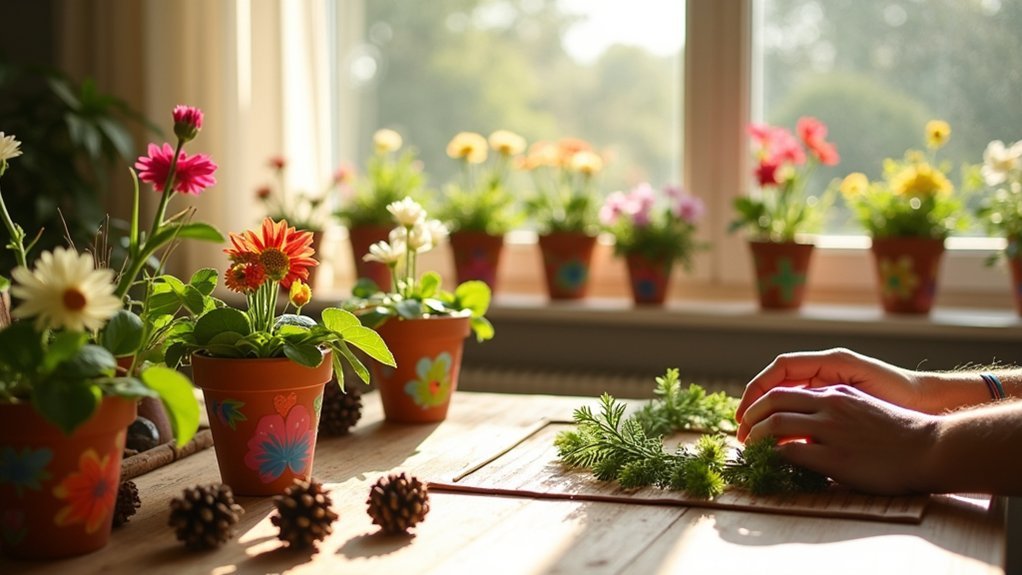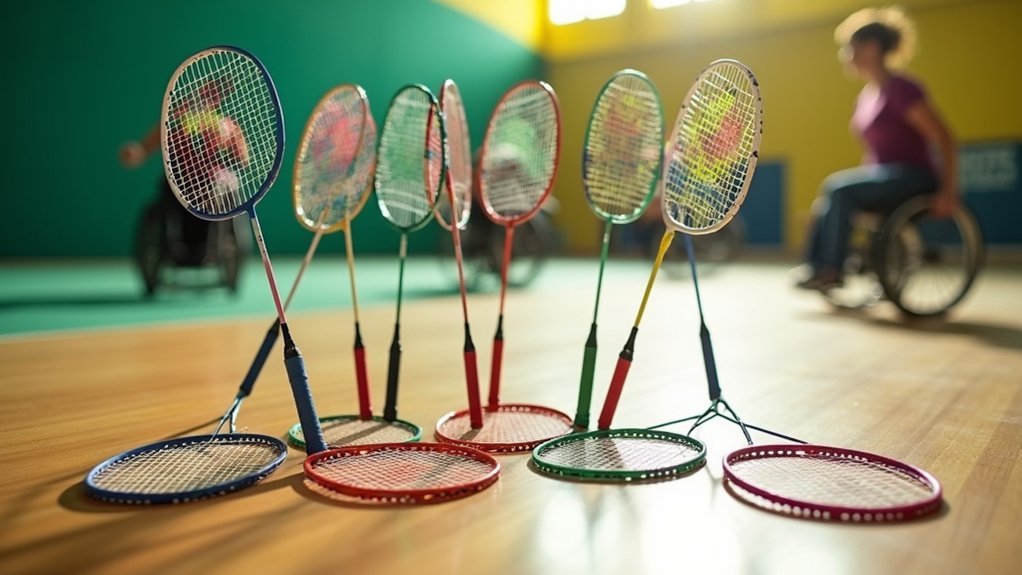Nature-based crafts offer powerful therapeutic benefits for dementia patients by reducing anxiety, stimulating sensory experiences, and triggering memory recall. You’ll find simple yet effective activities like sensory leaf collages, rock painting, bird feeders, pressed flower bookmarks, and herb garden boxes particularly beneficial. These crafts connect patients with familiar elements while improving cognitive function and emotional well-being. Whether in group or individual sessions, these activities foster meaningful connections and create moments of joy. The healing journey continues through nature’s gentle touch.
The Healing Power of Nature for Dementia Patients

While medical interventions play an essential role in dementia care, the therapeutic benefits of nature often receive less attention despite their profound impact.
Research shows that regular engagement with natural environments can greatly reduce anxiety and agitation in your loved ones living with dementia.
You’ll notice improved cognitive function and elevated mood when incorporating nature walks into their routine. These outdoor activities not only promote physical exercise—crucial for maintaining overall health—but also stimulate sensory experiences that can trigger memory recall and personal connections.
When your family member interacts with natural elements like leaves, flowers, or stones, they’re accessing multiple sensory pathways that support emotional well-being.
This sensory stimulation creates moments of presence and calm, offering a respite from the confusion and frustration often associated with dementia.
Sensory Leaf Collages: Connecting With Seasonal Changes
Five distinct seasons offer unique opportunities for creating sensory leaf collages with your loved one experiencing dementia. This simple yet effective dementia activity combines nature’s textures, colors, and scents to stimulate memories and cognitive function.
Begin by collecting leaves together outdoors—a therapeutic experience itself that encourages physical movement and nature connection. The process of arranging and gluing leaves develops fine motor skills while providing creative expression without perfection pressure.
As you craft together, discuss leaf varieties and seasonal changes to promote conversation and social engagement. Crafts art therapy like this creates valuable moments of connection while the finished collages serve as tangible achievements that ground patients in the present moment.
These natural art pieces become visual reminders of your shared creative experience and nature’s ongoing transformations.
Rock Painting: Transforming Natural Elements Into Art

Rock painting offers powerful sensory benefits through the smooth texture of stones and vibrant colors that stimulate tactile awareness in individuals with dementia.
You’ll find these natural canvases create meaningful memory connection points as participants associate the rocks with outdoor experiences or special places they’ve visited.
To begin this therapeutic activity, you can collect smooth stones from a garden center, coat them with white primer, provide easy-grip paintbrushes with acrylic paints, and encourage simple patterns or meaningful symbols.
Sensory Benefits
The transformation of ordinary stones into vibrant works of art offers powerful sensory stimulation for individuals with dementia. As they hold smooth rocks in their hands and apply colorful paints, you’ll notice improved cognitive function through multisensory engagement.
The tactile experience of handling natural stones paired with the visual richness of bright colors creates meaningful connections that access different areas of the brain.
- Touch sensation – The smooth, cool surface of rocks provides comforting tactile feedback that grounds patients in the present moment.
- Visual stimulation – Vivid colors activate visual processing centers, enhancing focus and attention.
- Rhythmic movement – The repetitive motions of painting promote relaxation and mindfulness, reducing anxiety common in dementia care.
These sensory benefits extend beyond the activity itself, creating lasting emotional and cognitive improvements.
Memory Connection Points
When patients transform ordinary stones into colorful art pieces, they often access deeply embedded memories that might otherwise remain dormant. These painted rocks serve as tangible memory connection points, sparking conversations about nature walks, childhood collections, or special places they’ve visited.
You’ll notice how holding a smooth stone can trigger sensory recollections while the act of painting activates creative pathways in the brain. During these creative activities, participants might spontaneously share stories about beach trips or gardens they once tended.
The finished artworks become conversation starters that family members can use during visits. “Tell me about this blue pattern” might lead to rich discussions about favorite colors or meaningful symbols, fostering connections that transcend cognitive limitations while strengthening emotional bonds through shared artistic experiences.
Guided Activity Steps
Preparing a rock painting session requires minimal materials but yields meaningful engagement for dementia patients. These nature-inspired crafts provide sensory stimulation while encouraging self-expression in a structured environment that feels safe and familiar.
- Gather and Prepare Materials – Collect smooth, flat rocks from nature or craft stores, wash them thoroughly, and verify they’re completely dry before the activity begins.
- Set Up Creative Stations – Arrange non-toxic acrylic paints, various brush sizes, and water cups at each seat, keeping the workspace organized to minimize confusion.
- Guide Without Controlling – Demonstrate simple techniques like dots, lines, or basic shapes, then encourage seniors to paint familiar themes like flowers or animals, adapting your support based on individual abilities.
These activities promote fine motor skills while creating keepsakes that boost participants’ self-esteem.
Creating Bird Feeders: Supporting Wildlife Engagement

Many individuals with dementia find profound joy in connecting with nature and wildlife, making bird feeder projects an ideal therapeutic craft.
You’ll discover that simple pine cone feeders coated with peanut butter and rolled in birdseed are perfect for dementia patients who might otherwise struggle with creating collages or more complex crafts.
These sensory-rich projects encourage fine motor skills as participants spread peanut butter and sprinkle seeds.
Once completed and hung outside, the feeders transform into ongoing sources of engagement as birds visit throughout the day.
This wildlife connection reduces stress and improves emotional well-being while creating natural opportunities for social interaction.
Residents can share observations about visiting birds with caregivers and family members, fostering meaningful conversations that extend beyond the initial crafting session.
Pressed Flower Bookmarks: Preserving Nature’s Beauty
You’ll find that collecting flowers outdoors stimulates recall as seniors connect with familiar plants and seasonal blooms.
The process of handling, arranging, and pressing delicate petals offers meaningful tactile stimulation that engages multiple senses simultaneously.
This straightforward craft creates a peaceful rhythm of activity that can reduce anxiety while producing a tangible keepsake to cherish.
Memory-Enhancing Outdoor Collection
Three simple materials—flowers, cardstock, and time—transform an outdoor walk into a lasting memory with pressed flower bookmarks. This therapeutic craft for dementia patients combines nature exploration with creative expression, stimulating cognitive function while providing sensory engagement.
Begin your collection journey by:
- Inviting participants to select their favorite blooms during walks, encouraging them to discuss flower names and personal connections.
- Guiding them to carefully place their selections between book pages, explaining how pressure preserves the delicate petals.
- Creating conversations about outdoor memories while waiting for flowers to press, strengthening recall abilities.
This craft idea offers more than just a beautiful bookmark—it’s a tangible connection to nature that promotes reminiscence, fine motor skills, and meaningful engagement for those with dementia.
Sensory Tactile Engagement
Beyond their visual appeal, pressed flower bookmarks offer rich tactile experiences that engage multiple senses for dementia patients. When working with seniors, you’ll notice how the different textures of petals and leaves help dementia patients reconnect with natural elements they’ve known throughout their lives.
| Sensory Element | Benefit | Activity |
|---|---|---|
| Touch | Stimulates tactile memories | Handling dried flowers and arranging them |
| Visual | Triggers recognition of familiar plants | Selecting colorful blooms for pressing |
| Scent | Activates olfactory memories | Smelling flowers before pressing them |
The process can be broken into manageable steps—collecting flowers one day, pressing them the next, and assembling bookmarks later. This approach accommodates shorter attention spans while still providing a satisfying creative outlet that produces practical, beautiful keepsakes they can use or gift to others.
Simple Calming Activity
Pressed flower bookmarks offer a wonderfully calming activity that’s perfectly suited for dementia care settings. This Easy Craft for Seniors connects participants with nature while creating lasting keepsakes they’ll treasure.
Your loved ones will benefit from both the gentle process and the sensory stimulation provided by colorful blooms and natural fragrances.
- Collect flowers together during a short outdoor walk, choosing favorites that evoke personal memories.
- Place flowers between heavy book pages for 3-5 days, checking occasionally to monitor the drying process.
- Once dried, arrange and adhere flowers to cardstock, sealing with clear contact paper for a functional bookmark.
The completed bookmarks serve as meaningful achievements and can become cherished gifts, reinforcing connections and providing purposeful engagement through simple, accessible creativity.
Herb Garden Sensory Boxes: Aromatic Memory Triggers
Simple herb garden sensory boxes offer five powerful memory triggers for individuals living with dementia. Using small containers filled with rosemary, mint, and lavender, you’ll help improve sensory stimulation that calms anxiety and enhances mood in older adults.
Label each herb with its name and uses to encourage cognitive engagement and spark conversations about familiar cooking experiences. The textures and scents provide immediate sensory feedback that promotes relaxation while reducing agitation.
The assembly and maintenance of these boxes fosters purpose and accomplishment, connecting patients more deeply to their environment. Regular interaction serves as a gentle bridge to personal history, aiding memory recall and emotional well-being.
These aromatic triggers create meaningful moments where past and present connect through the power of scent.
Nature-Inspired Mobiles: Bringing the Outdoors Inside
The gentle swaying of nature-inspired mobiles creates a calming effect that can soothe agitated residents and provide visual stimulation throughout the day.
You’ll find that incorporating familiar elements like seasonal flowers or leaves can trigger powerful memories and spark spontaneous conversations about past experiences with nature.
These hanging displays work wonderfully as conversation starters during family visits, giving loved ones with dementia a tangible connection to the natural world they may no longer regularly experience.
Soothing Motion Effects
While gentle movement captivates our attention in nature, it can also provide remarkable therapeutic benefits for dementia patients through carefully crafted mobiles. The soothing motion of these hanging creations acts as a calming focal point, reducing anxiety and promoting relaxation in ways that enhance overall health.
When you introduce nature-inspired mobiles into care settings, you’ll observe:
- Decreased agitation and restlessness as patients focus on the gentle, hypnotic movements.
- Improved emotional responses through the visual connection to familiar natural elements.
- Enhanced social engagement as residents share observations and memories triggered by the mobiles.
These simple yet effective tools work by mimicking nature’s rhythm, creating a mindful moment that helps ground patients in the present while simultaneously evoking positive memories of outdoor experiences.
Memory-Triggering Elements
Beyond their calming movements, nature-inspired mobiles serve as powerful memory catalysts for dementia patients, connecting them with familiar outdoor experiences through carefully selected elements.
When crafting these mobiles, you’ll want to incorporate items that evoke specific seasonal memories—autumn leaves, spring flowers, or beach shells can trigger personal associations and stories.
These memory-triggering elements work best when combined with bright colors and varied textures that stimulate multiple senses. Activities can help residents engage cognitively as they select and arrange materials, making decisions that exercise their remaining abilities.
When family members participate in creating these nature mobiles, they often discover that shared crafting opens channels for communication and connection that might otherwise remain closed.
The completed mobiles, displayed in common areas, continue to spark recognition and conversation long after the creative session ends.
Therapeutic Benefits of Nature-Based Activities
Research consistently shows that connecting with nature offers profound therapeutic advantages for individuals living with dementia. When you incorporate nature-based activities into care routines, you’re providing multiple pathways for engagement and healing.
Natural environments stimulate cognitive function, improving memory recall and attention spans in remarkable ways.
- Stress reduction – Nature exposure considerably lowers anxiety levels, creating a calming effect that improves emotional well-being.
- Physical health improvement – Outdoor activities encourage movement, helping to slow symptom progression and enhance mood.
- Social connection – Nature crafts foster meaningful interactions, reducing isolation often experienced by those with dementia.
Using natural materials like leaves and flowers provides valuable sensory stimulation, helping patients connect with familiar elements from their environment while encouraging creative expression.
Adapting Nature Crafts for Different Stages of Dementia
As dementia progresses through various stages, you’ll need to thoughtfully adjust nature-based activities to match changing abilities and needs.
In early stages, encourage creativity with leaf collages or flower arranging that stimulate memory recall. These nature crafts can feature larger, more tactile materials that are easier to handle.
For middle stages, incorporate more guidance while maintaining engagement. Pre-assembled nature kits with minimal assembly requirements work well for those with advanced dementia, preventing frustration while still providing a sense of accomplishment.
Consider preceding craft sessions with nature walks to spark memories and inspiration.
Always integrate familiar themes—favorite plants or meaningful colors—to strengthen emotional connections.
The key is providing sensory-rich experiences with scented flowers or textured materials that remain accessible regardless of cognitive ability.
Seasonal Craft Ideas: Engaging Year-Round With Nature
The changing seasons offer an abundant palette of natural materials that can transform dementia care through engaging craft activities.
Nature’s seasonal gifts provide endless creative possibilities for meaningful engagement in dementia care.
You’ll find that seasonal crafts connect patients to time and place while stimulating sensory experiences that enhance memory recall. Nature-themed projects like pine cone bird feeders not only improve fine motor skills but also encourage meaningful outdoor interaction.
- Fall: Try leaf printing with vibrant autumn colors to evoke emotional responses and create personalized artwork.
- Spring: Introduce flower pressing activities that preserve delicate blooms while providing tactile stimulation.
- Winter: Create textured collages using pine needles, dried berries, and other winter elements to maintain engagement during indoor months.
These accessible activities can be tailored to all ability levels, fostering accomplishment while facilitating social connections through group crafting sessions.
Group vs. Individual Nature Craft Sessions
When considering therapeutic approaches for dementia care, deciding between group and individual nature craft sessions becomes a critical choice that affects participant outcomes.
Group sessions create valuable social connections, reducing isolation while fostering community bonds as participants share ideas and collaborate. This supportive environment stimulates cognitive function and enhances the sense of belonging that many with dementia crave.
In contrast, individual sessions provide personalized attention tailored to specific interests and abilities. Participants work at their own pace with focused sensory engagement using natural materials like leaves and flowers. This personalized approach can better alleviate stress and promote relaxation.
Both formats effectively incorporate familiar themes and tactile materials that enhance memory recall, though your choice should reflect the unique needs and preferences of those in your care.
Incorporating Familiar Natural Elements From Patient’s Past
Connecting with a patient’s personal history represents a powerful dimension of nature-based therapeutic crafts. When you introduce natural elements that resonate with their past experiences, you’re opening doors to memories that might otherwise remain closed.
Patients often share stories spontaneously when handling materials that feel familiar to them.
- Select materials specific to the patient’s background—seashells for someone who lived near the ocean, pine cones for those from wooded regions, or local wildflowers that grew near their childhood home.
- Incorporate seasonal elements that match significant periods in their lives, like harvest materials for someone with farming experience.
- Use scented natural materials like lavender or rosemary that might trigger sensory memories connected to their personal history.
Supporting Caregivers: Nature Craft Preparation Techniques
Successful implementation of nature crafts relies heavily on thoughtful preparation by caregivers, who often serve as the bridge between therapeutic intentions and practical application.
To help your loved ones engage meaningfully, organize all materials beforehand, ensuring items are easily accessible for those with limited mobility or cognitive challenges.
Create a calm, distraction-free environment where seniors can focus on the activity. Select simple, familiar natural elements like leaves, flowers, and twigs that might evoke pleasant memories. These seasonal materials can stimulate sensory engagement and spark conversations about changing seasons.
Prepare clear, step-by-step instructions that promote independence while minimizing confusion.
Frequently Asked Questions
What Are Good Crafts for People With Dementia?
You’ll find simple collages, rock painting, paper flowers, clay molding, and group crafts effective. These activities use familiar themes, bright colors, and tactile materials to stimulate cognition while promoting self-expression and social connection.
What Are Creative Activities for Dementia Patients?
You’ll find collage-making, painting with bright colors, bead jewelry creation, decorating memory boxes, and flower arranging beneficial. These activities stimulate creativity, enhance fine motor skills, and evoke memories while providing personal enjoyment.
What Are the Therapeutic Activities for People With Dementia?
You’ll find many therapeutic activities for dementia patients including arts and crafts, music therapy, reminiscence exercises, gentle physical activities, sensory stimulation, and group social interactions that enhance cognitive function and emotional well-being.
What Type of Art Is Best for Dementia Patients?
Art that’s best for dementia patients includes familiar themes like nature or family. You’ll find they respond well to simple crafts with bright colors, tactile materials, and guided projects that allow self-expression without causing frustration.
In Summary
You’ve explored how therapeutic nature crafts offer meaningful sensory experiences for those with dementia. By incorporating natural elements into creative activities, you’ll forge connections to memories, stimulate cognition, and promote emotional well-being. Whether you’re gathering leaves, painting rocks, or pressing flowers, you’re providing more than just an activity—you’re creating moments of joy, purpose, and connection to the natural world that enhances quality of life.





Leave a Reply